The Big Bore Fun Page |
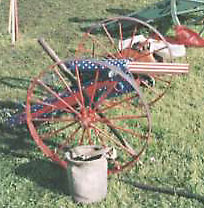
|
-Well, I suppose small bore can be fun, but I'm now a convertee to big bore guns: it takes something over 20mm to ring my chimes these days! Here you will find links and images relating to the people who fabricate and operate these monsters.
| Component: | Source: |
| Barrels and Cannons | Cannon, Ltd. |
| Barrels, cannon kits, complete cannons, ammo and supplies from 20mm to 155mm (wow!!), plus bowling ball mortars. The 4-page list of stock on hand is very impressive; Makes me wish I had deeper pockets!! |
CDSS Inc.
Spokane, WA (509) 535-9486 |
| Cannons: a large variety including models and full-sized | Cannon Mania |
| Barrels, Cannons and supplies (scale and full-size) |
Dixie Gun Works
Union City, Tn (800) 238-6785 |
| A two-pounder | Morgan Cannons |
| Barrels and Cannons | South Bend Replicas, Inc. |
| Barrels and Cannons | Steen Cannons |
| Barrels, 20-40mm | Old Western Scrounger |
| Cannon Carriage plans | http://www.victoria.tc.ca/~ud233/homepage.htm |
| Winchester Model 1898 breech-loading Cannons | Worthmarine.com |
-On a recent road trip I had to drive past this place. Sadly, I could only stop over for a few hours, but I did manage to take a few photos at the event.
-My descriptions are probably somewhat shy of correct terminology and I would appreciate it if knowledgable readers could send corrections as needed.
-If you know of any good dealers/sources for anyone wishing to build one of these monsters, let me know and I'll add them to the links.
| A home-made breech-loading cannon. Note the peep sites: many of the cannons there had these and were capable of remarkable accuracy. |
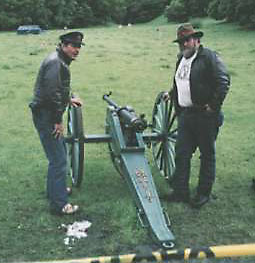
|
| Here is that same cannon being aimed. It could hit targets not more than a yard square at a range of about 100yds. |
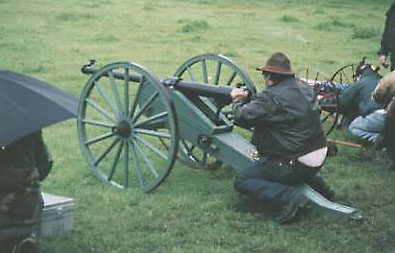
|
| This is called a Lyle gun (sp?) and is a large-ish example of the design, whose original purpose was to fire a weighted bar with a rope attached to an eyelet. Crews aboard ships still use these to "throw" lines across open seas, in order to tie up to other ships. The bore of this one was just right for firing soda cans filled with concrete. Another fellow had a smaller caliber rifle-style Lyle gun and shooting from the shoulder he scored a direct hit on the target. I saw a third Lyle gun launch an ironing board, attached to the other end of a rope, up into the air and downrange a good distance! |
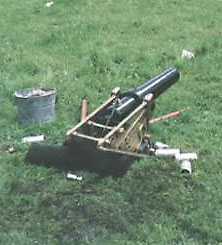
|
| I really liked the construction of the breech mechanism on this gun. It would be relatively easy to fabricate and it appears to be quite robust. |
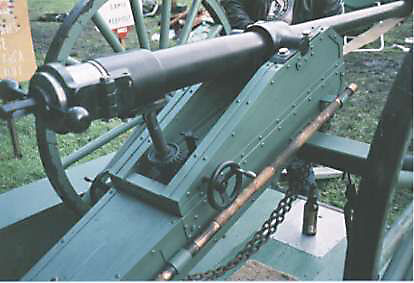
|
| About half of the firing line. Just beyond the bronze mount of the big Lyle gun are several mortars: the largest of these could hurl bowling balls more than 1/4 mile. Relatively speaking, they weren't all that noisy... |

|
| This mortar lobbed bowling pins more than 100 yards. I was amazed at their stability in flight: no tendency at all to tumble. The iron frying pan jammed handle-first into the earth prevents anyone standing behind the firing line from being scorched by flame jetting out of the touch-hole. |
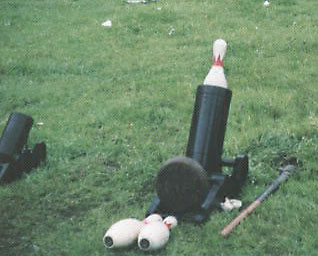
|
| This was my favorite cannon there. Built with parts from CDSS Inc. the barrel is salvaged from a rifled 20mm gatling gun, the kind used on navy ships to defend against missile attack. When the builder of this piece bought the barrel it had been sawn in two to "demilitarize" it. After carefully turning the sawn ends and chamfering them, he turned an aluminum bar to just the right o.d. and pressed it through the breech end until half of the bar, now with rifling grooves in it, protruded from the sawn end. The projecting bit served as a guide for the rifling twists of the other bit of barrel to be "screwed" into alignment. He then TIGged just a bit more barrel onto the end (still keeping the length within the legal limit) and pressed the aluminum back out through the breech. |
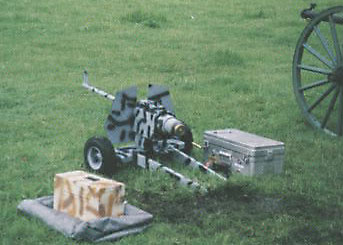
|
| Here's a close-up of the breech plug, which was threaded onto the end of the barrel. All cannons at the event used black powder and were fired with a bit of cherry bomb fuze or with a flintlock mechanism. This one used fuze which projeced from the nipple at the rear of the breech plug. |
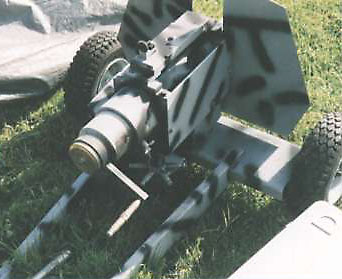
|
| Note the sliding block mechanism on the rear of this cannon. by turning the handle clockwise, a high-helix thread forced the breech block closed. Like several other cannons there, this one used brass cartridges which were assembled on the firing line (since it's illegal to transport ready-to-fire cartridges of this caliber). Typically, a pre-measured amount of black powder would be wrapped in aluminum foil and placed in the cartridge, which had already been fitted with a primer. A cast lead "bullet" would be gently placed atop this package and the whole would be pushed into the breech. |
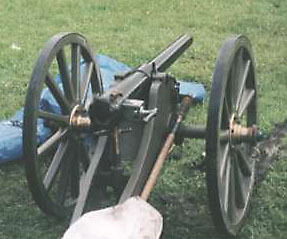
|
| This beauty was the most accurate cannon there, as well as the most well appointed. This is a Navy marine landing gun, typical of those used during the Spanish-American war. Just as there are Civil War re-enactments which one tends to see on the 4th of July, there are also re-enactments of Spanish-American war encounters. These guns are around 50 years more modern than their Civil War counterparts and the design reflects the changes wrought by time. Using the peep sights and taking a little time, this gun managed to place 7 shots into the target (a VW Vanagon) in a circle no bigger than a dinner plate, at a range of 100 yards! |

|
| Here's the VW out on the range, just before being peppered with all manner of projectiles. The orange blob in the foreground is a large pumpkin, which was blown up later, creating a huge mushroom cloud. |
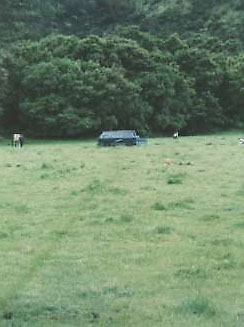
|
| After a volley from the skirmish line: the three upper holes are from .50 cal. muzzle-loading rifles and the two large exit holes ahead of the rear tire are (I believe) from 20 and 40mm cannon. Little deflection occurs from rounds of this size and it was possible to look straight through the van where one of these rounds had penetrated. |

|
Return to Road Trips Index
Return to Dangerous Hobbies